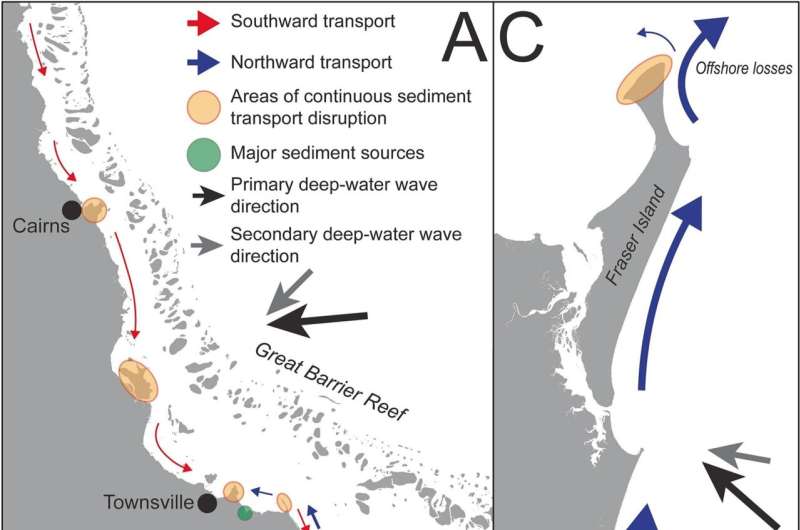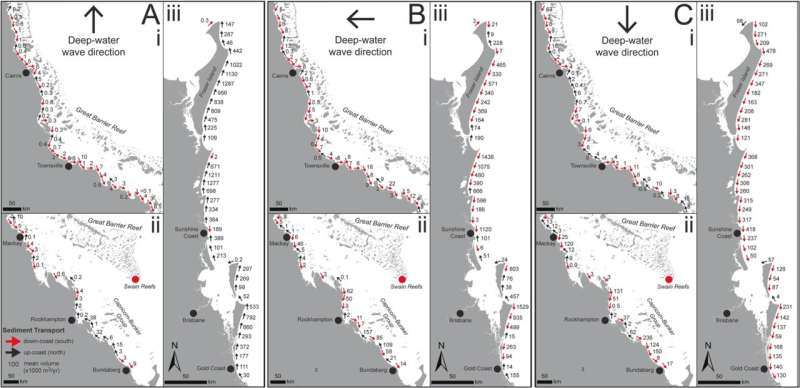August 7, 2023 feature
This article has been reviewed according to Science X's editorial process and policies. Editors have highlighted the following attributes while ensuring the content's credibility:
fact-checked
trusted source
proofread
Great Barrier Reef decline could impact Queensland's coastal erosion

Coastal wave action occurs due to complex interactions between offshore ocean conditions and the local landscape of the coastline, in addition to the effects of currents, tides and storms. It is an important process that affects the transport of sediment to and away from the shoreline, including beaches.
Sediment is suspended in the ocean from river runoff into the sea as well as waves disturbing the seabed, so are significantly impacted by heavy rainfall and storm events. In tropical and subtropical locations, the formation of reefs also strongly impacts wave energy reaching the coast and provides some protection against erosive action by changing the height, spacing and direction of waves.
Dr. Dylan Cowley and Dr. Daniel Harris from the University of Queensland, Australia, investigated the effect of the Great Barrier Reef on the transport of sediment to Australia's northeast coast by a process known as longshore drift. This is when waves bring sediment to the coast at an angle, but as the water recedes the backwash transports it directly away from the coastline at a 90 degree angle, causing material to move in a zig-zag pattern along the coastline. If it is not replenished sufficiently, this can result in erosion of the coastline in the "upstream" area and a build-up of sediment further "downstream."
Modeling research published in Marine Geology found that the Great Barrier Reef decreases the offshore wave energy while moving north up the coast. The scientists determined that over 500,000 m3 of sediment could be transported to the coastline by waves in the south of Queensland, while this reduces to less than 50,000 m3 when moving north along the coast to Fraser Island.
Dr. Cowley and Dr. Harris used a combination of computer modeling and real measurements from buoys along the coast to estimate a median wave height reaching the coast of 1 m to 2 m in the north of the study area, decreasing to less than 0.5 m around Fraser Island. Similarly, the wave period (the time it takes for two successive wave crests to pass the same point) reduced from eight to 10 seconds to three–five seconds, corresponding to an energy shift to lower swells. A change in dominant wave direction was also noted, from east-southeast to east-northeast.

This resulted in estimates of sediment transport volumes that varied significantly up the coast from 1,800,000 m3/year in southern Queensland, to 400,000 m3/year in the Capricorn Channel preceding the Great Barrier Reef, to less that 40,000 m3/year in the lagoon behind the reef.
The effect of offshore wave direction is a significant factor in the direction of longshore drift with those directed from the south causing greater northward transport of sediment along the south Queensland coast up to Fraser Island. However, local coastline makes the effects more variable northwards into the Capricorn Channel and Great Barrier Reef lagoon with even some southward transport dominating in the latter.
In the case of winds blowing from the north, the aforementioned scenario reverses in conjunction with the coastline changing from a predominant north-south orientation to a northwest-southeast orientation. The more open nature of the coastline south of Fraser Island and a steep narrow shelf makes it more susceptible to the offshore wave energy, higher swells and therefore more sediment transported to the coast.
Overall, the Queensland coast experiences a net positive increase in sediment being transported there, which can be exacerbated by southeasterly trade winds (winds blowing east to west near the equator) as well as extreme wave-generating events such as tropical cyclones and El Niño (a climate system occurring every two to seven years where the tropical ocean of the east Pacific becomes warmer). The latter can alter the wave direction to south and southeasterly, due to prevailing winds, and the intensity of the waves resulting from the overall energy in the atmosphere-ocean system during these events.
In the intervening La Niña phases (the opposite of El Niño with cooler temperatures in the tropical Pacific Ocean) increased rainfall brings more sediment to the coast from land runoff, meaning there is more available for transport. The researchers note the importance of this finding in particular as such extreme weather events are predicted to increase in frequency and magnitude in the decades to come, therefore impacting sediment transport.
With the Great Barrier Reef's continued decline, its potential for dissipating some of the incoming wave energy will likely be reduced, with waves of greater energy reaching the coastline having dual erosive and mobilizing effect. Understanding the changes in wave energy on sediment transport is important due to the increasing populations occupying coastal locations and the economic reliance upon them.
As significant changes to coastal regimes are expected over the coming decades due to climate change, the power of the oceans to transform our landscapes is a reminder of how we must seek to find ways to help the planet thrive through its natural processes, as well as those heightened by mankind's activities.
More information: Dylan Cowley et al, Wave-driven sediment transport potential on a tropical coast: Implications for the northeastern Australian sediment budget, Marine Geology (2023). DOI: 10.1016/j.margeo.2023.107104
© 2023 Science X Network



















